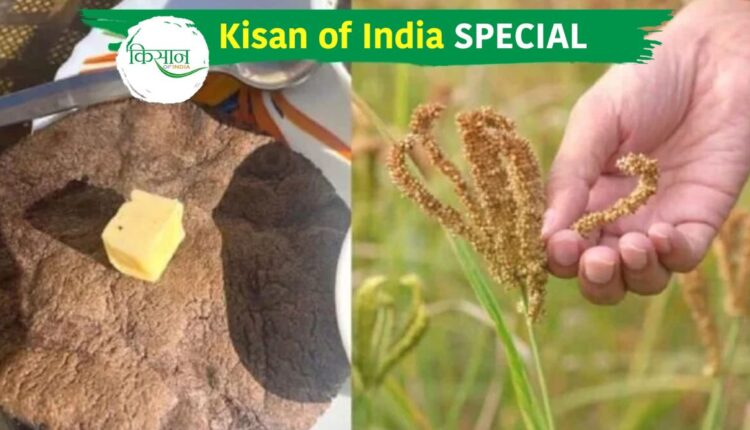Maduva-Jhunara are the solution to barren farming
These steps will encourage the cultivation of Maduva-Jhunara and coarse grains
Along with the traditions of our struggle, we grossly neglected our produce and food like Maduva-Jhunara. As a result, in 2001-2002, where we used to produce Maduva in 1 lakh 31 thousand hectare mountain land, in 2019-2020, this figure was reduced to 92 thousand hectare. Similarly, the area under production of jhungra has decreased from 67 thousand hectares to 49 thousand hectares. When we talk about the decrease in the area of these two crops, naturally other grains associated with these Kharif crops which are important pulses, in which the percentage of yield of Gahat, Bhat, Urad, Sesame, Tur, Rajma, Ramdana, also suffer scarcity.
Maduva-Jhunara grain is the basis of Uttarakhand’s identity
We can easily imagine the extent to which the economy of the hilly regions of Uttarakhand would have been hurt by the decrease in the production of these coarse grains. Overall, both these grains are the basis of Uttarakhand’s identity. The area under cultivation of both these grains has decreased by about 30 percent after the formation of the state. This 30 percent shortfall can be seen directly linked to Uttarakhand’s biggest crisis today of ‘migration and barren’ hill farming.
Importance of coarse grains Maduva-Jhunara
Due to barren farming, where the fields have been absorbed into the forest, monkeys, and langurs have reached our homes. Overall, the social crisis that has arisen due to the neglect of agriculture in people’s lives, we should recognize the importance of grains. By understanding it, we can save it only by increasing its production.
By promoting the cultivation of our traditional grains, we can achieve victory on many fronts simultaneously. While doing this, we have to pay attention to the fact that before independence, when the PDS system was not implemented in the country, even then the hilly areas used to solve their own food problem, that is, we were self-sufficient in the agriculture sector.
The Vivekananda Agricultural Research Institute, established by Boshi Sen in Almora in 1936, made a significant contribution to the development of mountain agriculture, seeds and technology. But in 1974 the autonomy and local character of this institute ended after its merger with the Council of Agricultural Research. After this, the process of work on local produce and seeds decreased here. This further created a crisis on the traditional agriculture and seeds of Uttarakhand, which we know as Barha Naja. This crisis over traditional seeds and farming did not arise only in Uttarakhand, but also in all the agro-based tribal areas like Chhattisgarh, Jharkhand, Assam, Andhra Pradesh, which had their own distinct local identity.
The crisis arose out of a conspiracy by the international fertilizer and seed nexus. This nexus arose out of the commercial ambitions of multinational fertilizer-seed companies imposed on third world countries in the name of agricultural reforms.
Campaign to save the traditional Baraha Naja
From around 1975, Soybean was attacked in hilly areas and Bhabar, then the team of Gandhian Dhoom Singh Negi, Vijay Jaddhari, Pratap Shikhar, Kunwar Prasun etc. in the self-sufficient valley of Gulf in Tehri recognized this crisis and started traditional Baraha Naja in the whole area. They launched a campaign too. In this campaign, seed tours were organized for the exchange of traditional seeds. The exchange of seeds is the knowledge acquired from our generations, which does not allow the productivity of the crop to decrease. This campaign was also honoured by Jamuna Lal Bajaj.
Maduva-Jhunara cultivation is the solution to many problems
Overall, if we say in short, then by identifying the mountain which is the identity of Maduva-Jhunara in true sense, by making special efforts for its production, we can solve many questions like migration and barren farming and employment of the youth in the mountainous region of Uttarakhand.
These steps will encourage the cultivation of coarse grains
In recent years, the central government has also made a policy for the protection of coarse grains, under which some important decisions were taken in December 2021. Under which FCI will market and distribute these coarse grains, as well as the old condition of sale within 3 months from the date of collection of coarse grains, has now been increased to seven to eight months.
This will definitely give more time to these grains for trading. Now the state government should make separate special efforts for the development of horticulture and grains which are the basis of mountain agriculture for the pride of the mountains. Create a research council of experts who will naturally work to provide certificates of organic certification to mountain organic farming and also provide necessary training to farmers. These centers can also be operated along with Krishi Seva Kendras.
Growing demand for coarse grains
The previous government had taken some steps for the protection of these coarse grains, as a result of which Maduva, which used to be sold at Rs 10 per kg, is now being sold at Rs 20-25 per kg from the village itself. The price of which in Delhi is ₹ 50 a kg, while the supply is not enough. In 2020, 200 tonnes of Maduva-Jhunara Himalayan millet have been exported to Denmark. Its demand is increasing in other European markets as well and all this is a good news for the hilly region of Uttarakhand.
2023 declared as International Millet Year
If our governments become aware in this direction, do collective farming through co-operative societies with government help on the barren farming land in the mountains, then definitely it will be a step to save the land and youth of the mountains. Also, it is important to include these health-enhancing coarse grains in your diet. 2023 has been recognized by the United Nations as the International Year of Millets. Along with this, the support price of Maduva has also been declared by the Uttarakhand government. All this augurs well for mountain agriculture.
Pramod Shah | Deputy Superintendent of Police in Uttarakhand Police, residence Haldwani Nainital, published articles on the history, social, cultural and agricultural side of Uttarakhand in various newspapers and social media platforms.
Also Read: Floriculture: Tuberose and Gladiolus flowers in the sugarcane belt
Contact us – If farmers want to share any valuable information or experiences related to farming, they can connect with us via phone or whatsapp at 9599273766 or you can write to us at “[email protected]”. Through Kisan of India, we will convey your message to the people, because we believe that if the farmers are advanced then the country is happy.
You can connect with Kisan of India on Facebook, Twitter, and Whatsapp and Subscribe to our YouTube channel.



